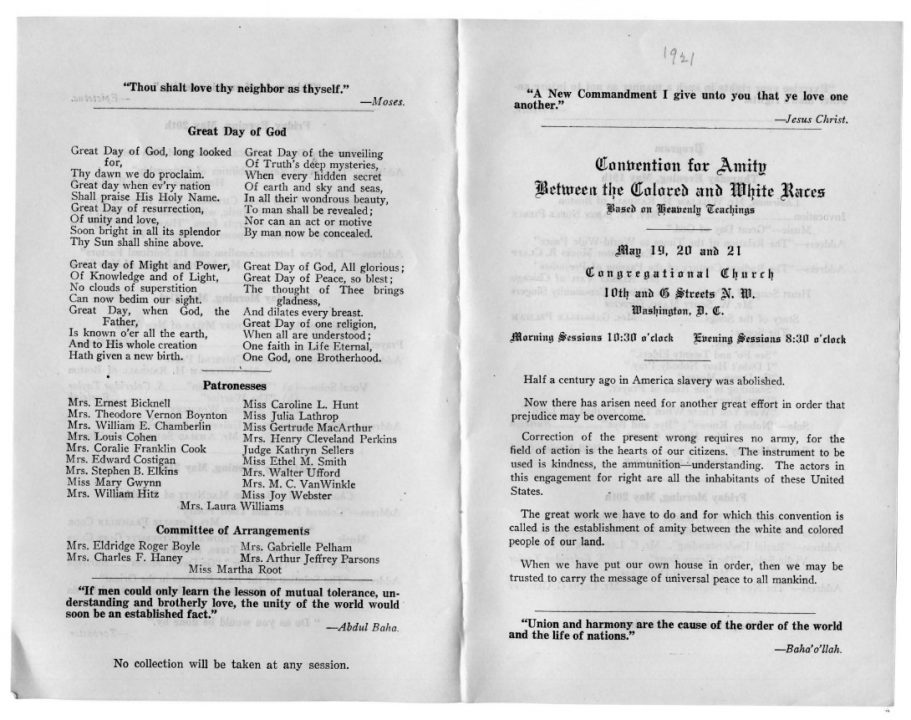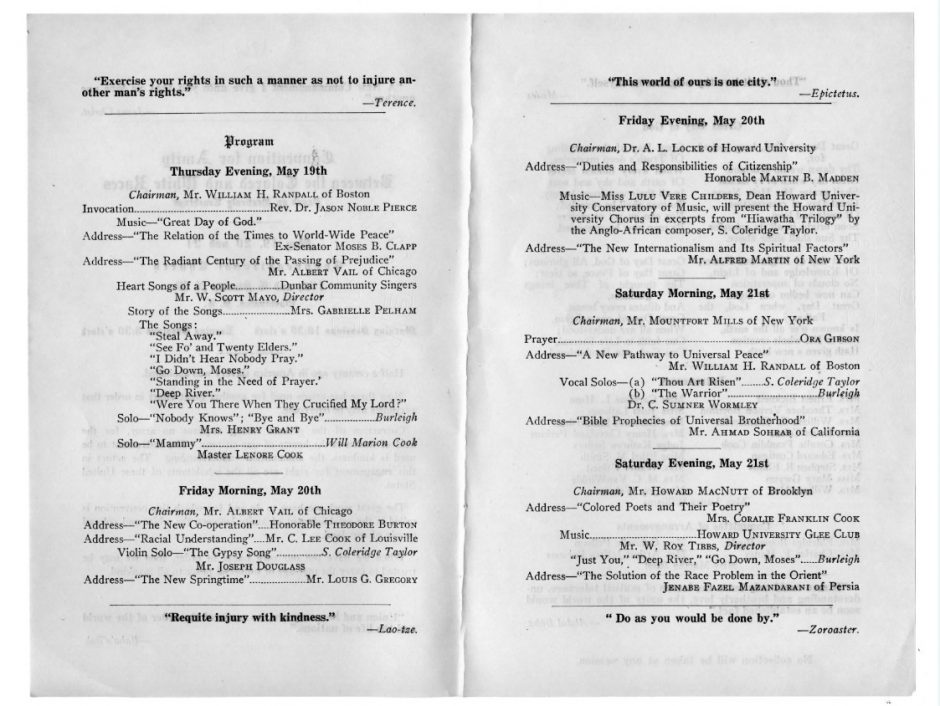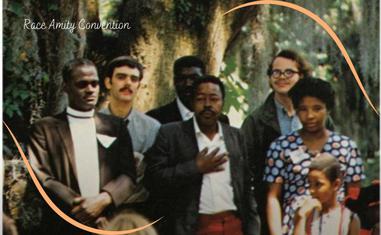The views expressed in our content reflect individual perspectives and do not represent the authoritative views of the Baha'i Faith.
Today marks the Centenary of the “Convention for Amity Between the Colored and White Races Based on Heavenly Teachings” held at the Congregational Church on 10th and G Street NW in Washington, DC.
Exactly a century ago on May 19–21, 1921, the American Baha’i community made perhaps its most dramatic and historic debut as the sponsor of this remarkable flagship meeting, the first such gathering since mob violence had torn the capital city apart less than two years before.
RELATED: Is Promoting Racial Unity a Spiritual Responsibility?
This three-day event launched a series of further Baha’i-sponsored “Race Amity” conferences. Notably, Howard University professors Coralie Franklin Cook and Alain Leroy Locke took part.
The American Baha’i community inaugurated its Race Amity movement in the nation’s capital, Washington DC, as “a practical effort to influence public discourse on race in the United States.” This came at a time when the “color line” between Black and white was drenched red with lynching and race riots that infected “Jim Crow” America with fear and dread.

One of the African American members of the audience during this three-day Convention was a certain M. F. Harris, whose voice rings out as the Black Everyman of his day. His full name and title was Rev. Marion Francis Harris, born April 3, 1874 in Arkansas. In the course of my archival research, I discovered a letter, dated Sunday, May 22, 1921, by Mr. Harris to Agnes Parsons, the Baha’i who became the lead organizer of this landmark event:
I attended every session, day and night … Many times throughout the meetings did with much effort restrain my tears. My heart leaped and throbbed and many times almost burst within my breast. I am a colored man … My race as a whole, I believe, is quite ready to welcome the glad day when all will be brothers. … The trouble is nearly unilateral. God give us the day.
Mr. Harris’s previously unpublished letter, hidden away in manuscript archives until I first published it in September of 2012, reflects a first-hand, genuine, even profound response to the Baha’i principle of the oneness of humankind, summarized here by Abdu’l-Baha:
For each and every people, and every religion, await a Promised One, and Baha’u’llah is that One Who is awaited by all; and therefore the Cause of Baha’u’llah will bring about the oneness of mankind, and the tabernacle of unity will be upraised on the heights of the world, and the banners of the universality of all humankind will be unfurled on the peaks of the earth.
The American Baha’i community thus sought to promote interracial harmony in race-stricken America during the Jim Crow era, which persisted, for decades, from approximately 1883 to 1964, often referred to as “America’s apartheid.”
More than progressive, Baha’i race amity initiatives were quite radical by the standards of their day, but such efforts were by no means exclusive. The Quakers (Society of Friends), for instance, held a conference on Inter-racial justice on October 24, 1924, one day after the fourth Baha’i Race Amity convention was held in Philadelphia. Baha’is, clearly in the forefront of race relations endeavors, also supported similar efforts by the NAACP and the National Urban League, the Quakers, and others.
This Baha’i activism had a leavening effect. Its full impact is impossible to determine, and it is further complicated by the fact that these early race-relations initiatives were part of a social evolution – some might say revolution – that historians may one day come to recognize as a significant milestone in American social history.
RELATED: How the Baha’i Faith Affirms and Empowers Black People
The Baha’i race amity era lasted from 1921–1936, followed by a race unity period of 1939–1947, succeeded by a whole range of Baha’i race relations initiatives, such as the Baha’i sponsorship of Race Unity Day into the present. The 1991 Baha’i statement “The Vision of Race Unity,” together with the video, “The Power of Race Unity,” have their roots in early Baha’i race initiatives in which Alain Locke and others, such as the great Baha’i champion of promoting ideal race relations, Louis Gregory, played an important role. The historical origins of the Baha’i race amity movement, therefore, can be traced not only to Abdu’l-Baha’s vision of ideal race relations, but to his own personal involvement – he initially conceived and inaugurated the race amity movement.
Preparations for the first Race Amity conference began when Abdu’l-Baha asked Agnes S. Parsons, a white woman prominent in Washington high society, “to arrange in Washington a convention for unity between the white and colored people.”
This came as quite a shock to Mrs. Parsons, who had no prior experience in race relations. Abdu’l-Baha advised Agnes Parsons not to undertake this alone. Accordingly, Parsons consulted with the Washington Baha’i assembly (a nine-member, elected council) for advice and called upon several of her friends to form an ad hoc race amity convention committee. This task force included Agnes Parsons herself, Mariam Haney, Louise Boyle, Gabrielle Pelham and the globe-trotting Baha’i journalist, Martha Root.
The first race amity committee appointed a Baha’i chairperson to preside over each session, which primarily featured speakers from outside the Baha’i community. According to Agnes Parsons, “At each session of the convention there was a Baha’i chairman and the chairman invariably gave the keynote for the whole evening.” All of the thoughtful planning paid off, making the convention a resounding success. These progressive, pioneering conferences, held when racial amity and the elimination of prejudice seemed a travesty to some Americans and an unreachable ideal to others, paved the way for future efforts to bridge the racial divide in America and the world.
The distinguished Baha’i philosopher and dean of the Harlem Renaissance, Dr. Alain Leroy Locke (1885–1954), served as session chair of the first Race Amity conference on Friday evening, May 20, 1921. In Locke’s philosophy of democracy, if America could transform its racial injustice into racial equality, America would then have the moral basis to fulfill its global role as a spiritual leader. In this sense, the Baha’i Faith, a transplanted religion with Middle Eastern origins, adhered more truly to American ideals than even America itself.
Perhaps the best way to begin to describe the Race Amity program as performed is to examine the program as printed, which contained the essence of what the convention was designed to convey:
Half a century ago in America slavery was abolished.
Now there has arisen need for another great effort in order that prejudice may be overcome.
Correction of the present wrong requires no army, for the field of action is the hearts of our citizens. The instrument to be used is kindness, the ammunition – understanding. The actors in this engagement for right are all the inhabitants of these United States.
The great work we have to do and for which this convention is called is the establishment of amity between the white and the colored people of our land.
When we have put our own house in order, then we may be trusted to carry the message of universal peace to all mankind.

On February 1, 2012, Cornel West, Professor of African American Studies and Religion at Princeton University, paid tribute to the historic Baha’i efforts to foster ideal race relations in America:
I have come to have a profound admiration for brothers and sisters of the Baha’i Faith. I’ve actually met Dizzy Gillespie and he, of course, one of the great artists of the twentieth century, was of Baha’i Faith, and talked over and over again about what it meant to him. Alain Locke, of course, probably one of the greatest philosophic minds of the middle part of the twentieth century, was also of Baha’i Faith, the first Black Rhodes scholar and chairman of the philosophy department at Howard University, for over forty-two years. What I’ve always been taken by is the very genuine universalism of the Baha’i Faith, one of the first religious groups to really hit racism and white supremacy head on, decades ago. By decades, I mean many decades ago and remain consistent about it.
When you talk about race and the legacy of white supremacy, there’s no doubt that when the history is written, the true history is written, the history of this country, the Baha’i Faith will be one of the leaven in the American loaf that allowed the democratic loaf to expand because of the anti-racist witness of those of Baha’i Faith. So that there is a real sense in which a Christian like myself is profoundly humbled before Baha’i brothers and sisters and the Dizzy Gillespie’s and the Alain Locke’s and so forth. – Professor Cornel West, “Towards Oneness.”
If and when, as suggested by Cornel West, a revisionist history of the Jim Crow era is written, the contribution of the Baha’i “race amity” initiatives – envisioned, conceptualized and mandated by Abdu’l-Baha himself – should take its rightful place in the annals of American history.
A new “National Race Amity Virtual Conference Centenary Celebration 1921–2021” will be held May 21–23, 2021. Its motto, or watchword, is worth noting: “Cross-racial and cross-cultural amity – friendship – [is] found at the core of all advances for access, equity, and social justice.” One of the keynote speakers will be philosopher, political activist, social critic, and public intellectual, Dr. Cornel West. Registration is available at the conference website above, and everyone is invited to attend.

















Comments
Sign in or create an account
Continue with Facebookor